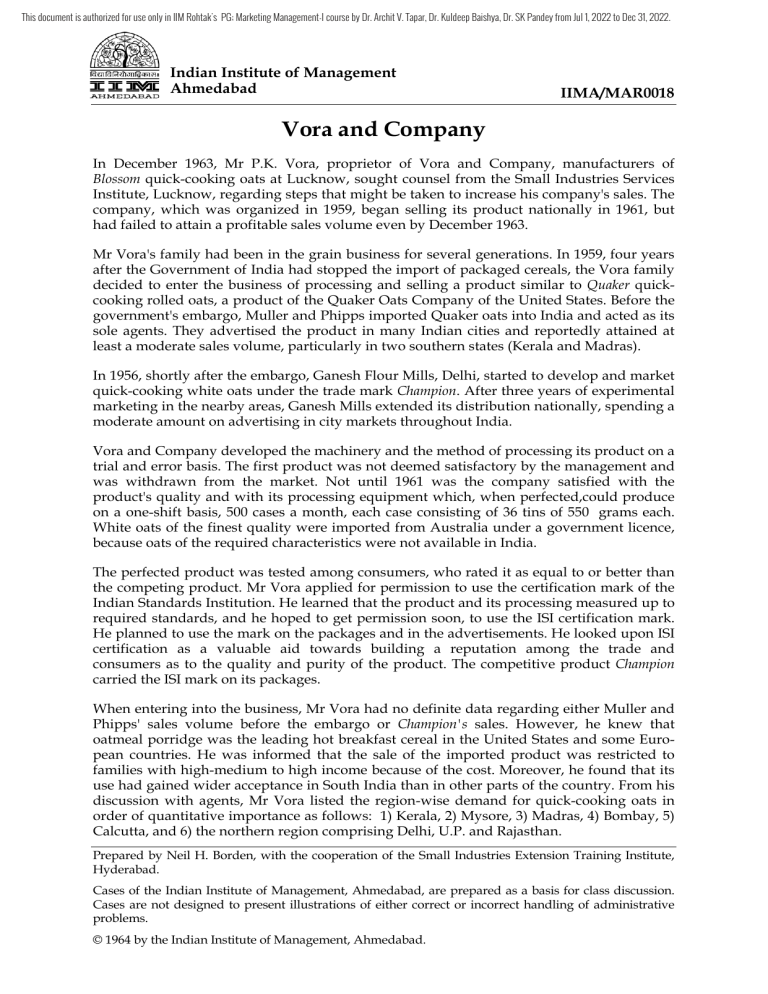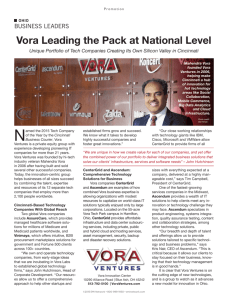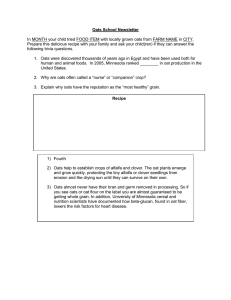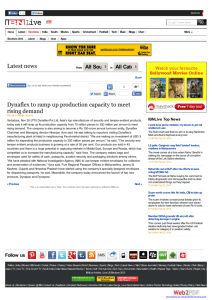
This document is authorized for use only in IIM Rohtak's PG; Marketing Management-I course by Dr. Archit V. Tapar, Dr. Kuldeep Baishya, Dr. SK Pandey from Jul 1, 2022 to Dec 31, 2022. Indian Institute of Management Ahmedabad IIMA/MAR0018 Vora and Company In December 1963, Mr P.K. Vora, proprietor of Vora and Company, manufacturers of Blossom quick-cooking oats at Lucknow, sought counsel from the Small Industries Services Institute, Lucknow, regarding steps that might be taken to increase his company's sales. The company, which was organized in 1959, began selling its product nationally in 1961, but had failed to attain a profitable sales volume even by December 1963. Mr Vora's family had been in the grain business for several generations. In 1959, four years after the Government of India had stopped the import of packaged cereals, the Vora family decided to enter the business of processing and selling a product similar to Quaker quickcooking rolled oats, a product of the Quaker Oats Company of the United States. Before the government's embargo, Muller and Phipps imported Quaker oats into India and acted as its sole agents. They advertised the product in many Indian cities and reportedly attained at least a moderate sales volume, particularly in two southern states (Kerala and Madras). In 1956, shortly after the embargo, Ganesh Flour Mills, Delhi, started to develop and market quick-cooking white oats under the trade mark Champion. After three years of experimental marketing in the nearby areas, Ganesh Mills extended its distribution nationally, spending a moderate amount on advertising in city markets throughout India. Vora and Company developed the machinery and the method of processing its product on a trial and error basis. The first product was not deemed satisfactory by the management and was withdrawn from the market. Not until 1961 was the company satisfied with the product's quality and with its processing equipment which, when perfected,could produce on a one-shift basis, 500 cases a month, each case consisting of 36 tins of 550 grams each. White oats of the finest quality were imported from Australia under a government licence, because oats of the required characteristics were not available in India. The perfected product was tested among consumers, who rated it as equal to or better than the competing product. Mr Vora applied for permission to use the certification mark of the Indian Standards Institution. He learned that the product and its processing measured up to required standards, and he hoped to get permission soon, to use the ISI certification mark. He planned to use the mark on the packages and in the advertisements. He looked upon ISI certification as a valuable aid towards building a reputation among the trade and consumers as to the quality and purity of the product. The competitive product Champion carried the ISI mark on its packages. When entering into the business, Mr Vora had no definite data regarding either Muller and Phipps' sales volume before the embargo or Champion's sales. However, he knew that oatmeal porridge was the leading hot breakfast cereal in the United States and some European countries. He was informed that the sale of the imported product was restricted to families with high-medium to high income because of the cost. Moreover, he found that its use had gained wider acceptance in South India than in other parts of the country. From his discussion with agents, Mr Vora listed the region-wise demand for quick-cooking oats in order of quantitative importance as follows: 1) Kerala, 2) Mysore, 3) Madras, 4) Bombay, 5) Calcutta, and 6) the northern region comprising Delhi, U.P. and Rajasthan. Prepared by Neil H. Borden, with the cooperation of the Small Industries Extension Training Institute, Hyderabad. Cases of the Indian Institute of Management, Ahmedabad, are prepared as a basis for class discussion. Cases are not designed to present illustrations of either correct or incorrect handling of administrative problems. © 1964 by the Indian Institute of Management, Ahmedabad. This document is authorized for use only in IIM Rohtak's PG; Marketing Management-I course by Dr. Archit V. Tapar, Dr. Kuldeep Baishya, Dr. SK Pandey from Jul 1, 2022 to Dec 31, 2022. 2 of 4 IIMA/MAR0018 Apart from the high nutritive value of oatmeal porridge, its taste when taken with milk and sugar or with butter or syrup was liked by many. The quick-cooking oats appealed to many housewives, because they had to be boiled for only four to five minutes to be ready to serve. The older variety of rolled oats required about 30 minutes of cooking. Moreover, since the housewife had to exercise care to prevent the porridge from sticking to the pan and scorching, either by stirring frequently or cooking over a low fire, or by cooking in a double boiler, the long-cooking type was less appealing than the new quick-cooking type, which was pre-cooked in manufacture after the oat grain had been split and rolled. Packaging and Trade Mark Vora and Company adopted a round, heavy tin package similar to the one used for Champion, which, in turn, was presumably patterned after the Quaker package. Vora adopted the trade mark Blossom. The background had the brand name in large red type at the top of the can. Directly below there was an illustration of several sheaves of oats and a smiling girl. Champion carried the smiling face of a young boy. Beneath the left half of the illustration in large white type was the phrase “White Oats” with the word White over the word Oats. The phrase “quick-cooking” in smaller type was to the right of the white oats lettering. The Blossom tin contained 550 grams of oats, the same quantity which was in the largest selling package of Champion. Ganesh Mills, however, also marketed a tin of 750 grams. Quaker oats had been sold in 500 gram tins. Each Blossom case delivered to the retailer contained 36 tins. The Champion case also contained 36 tins. Distribution Channels and Terms of Sale Vora appointed distribution agents, who were generally selling non-competing food products, with exclusive regional rights. For instance, for the states of Punjab, U.P., Rajasthan, and Jammu and Kashmir, and for the Delhi territory, he appointed Messrs R.C. Ramanathan of New Delhi as exclusive agents for selling the product to retailers. This agent also handled the products of a large, well-known packaged food manufacturer. Messrs R.C. Ramanathan were granted a commission of 10 per cent off the list price. They had three permanent salesmen covering their territory. They also appointed sub-agents in large towns or cities such as Delhi, Agra, Gwalior and Mussoorie. The sub-agents received 2.5 per cent off list price out of the agent's commission. Retailers received a trade discount of 10 per cent off list price. So Vora and Company received 20 per cent less from the list price. The company appointed agents for the remaining states on the same terms. The agents and sub-agents did not act as full-fledged wholesale distributors performing the functions of buying, stocking, and distributing Blossom in their territories. They merely acted as indenting agents, taking orders in case lots from retailers for shipment by Vora and Company from Lucknow. The agents merely guaranteed acceptance of delivery and payment of orders. The company shipped its product FOR destination with a bank draft attached to the invoice, which was released for delivery of the shipment on payment of the draft. Mr Vora reported that in the southern states of Madras, Kerala and Mysore, which were the largest consumers of oats, sales had been disappointing. The agent appointed for these states was new to the sale of food products. The agency, for some time, had no salesmen of its own, calling on retailers and the sub-distributors appointed with selling rights for This document is authorized for use only in IIM Rohtak's PG; Marketing Management-I course by Dr. Archit V. Tapar, Dr. Kuldeep Baishya, Dr. SK Pandey from Jul 1, 2022 to Dec 31, 2022. 3 of 4 IIMA/MAR0018 various areas. The total area had produced very little business for Blossom. On account of the sub-agents' sluggishness, the agent had recently reported employment of salesmen to push up the Blossom sales. Mr Vora had no practice of visiting his selling agents. He communicated with them by mail. Pricing In north India, the list price of Blossom was Rs 81 per case of 36 tins. In Bombay and south India, it was Rs 85. As stated earlier, the product was sold FOR destination. Vora and Company's receipts from the sales of each case were as follows: North India Bombay and south India Rs 64.00 (Rs 81.00 less 20 per cent) Rs 68.00 (Rs 85.00 less 20 per cent) Mr Vora stated that reports received from the trade gave the list price of Champion in north India as Rs 93 per case. Moreover, he was told that Champion's agents received 7.5 per cent off the list price as commission and the trade got a discount of 7.5 per cent off the list price. Champion reportedly sold its larger size tins at Rs 108 per case of 36 tins. These agents bought and stocked cases of Champion in their godowns for delivery to retailers. Sales The sales of Blossom in the two years following improvement of the processing had been irregular and had averaged far below plant capacity. From June to November 1963, sales averaged only 83 cases per month. Costs Mr Vora gave the breakdown of the costs per case for the June-November 1963 period as follows: Direct costs per case of 36 tins of 550 grams each (Rs) Material 24.12 Packing Tins 21.60 Other packing materials, wooden case, waterproof paper, box strapping pads 4.00 Direct Labour * 5.40 Railway Freight 4.80 * Mr Vora's monthly wage bill was Rs 900, but the work force was used at least half time on another project on which Mr Vora was engaged. In view of irregular production, the labour cost given was probably higher than what it would have been if the plant were operating at or near capacity. Monthly Overhead Costs (Rs) Rent Electricity and Water Coal Depreciation on plant @ 5 per cent (Rs 1 lakh investment) Interest on working capital 165 50 50 500 250 1015 This document is authorized for use only in IIM Rohtak's PG; Marketing Management-I course by Dr. Archit V. Tapar, Dr. Kuldeep Baishya, Dr. SK Pandey from Jul 1, 2022 to Dec 31, 2022. 4 of 4 IIMA/MAR0018 This overhead, allocated against the 500 cases sold during the period, came to Rs 12.18 per case. In the above figures, Mr Vora did not include any salary for himself. Advertising From the very start of national distribution, the selling agents had urged Mr Vora to advertise. For some months he undertook advertising in the major cities in which he had sales representation. After spending Rs 4,000, without any apparent sales response to justify such expenditure, he stopped advertising. Despite the considerable losses he had suffered since the launching of his enterprise, Mr Vora was anxious to make a success of his business. He was willing to put more money into the venture if suggested changes gave promise of bringing profitable sales. Question As counsel, what advice would you give Mr Vora regarding the procedures he should adopt?







